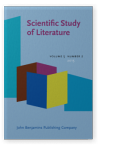Lin, Yeqiang (Kevin), Ondrej Mitas, Ye (Sandy) Shen, Marcel Bastiaansen & Wim Strijbosch
2024.
Objective Measurement of Experiences in Tourism and Hospitality: A Systematic Review of Methodological Approaches and Best Practices.
Journal of Hospitality & Tourism Research 
Papp-Zipernovszky, Orsolya, Anne Mangen, Arthur Jacobs & Jana Lüdtke
2022.
Shakespeare sonnet reading: An empirical study of emotional responses.
Language and Literature: International Journal of Stylistics 31:3
► pp. 296 ff.

Hugentobler, Katharina Gloria & Jana Lüdtke
2021.
Micropoetry Meets Neurocognitive Poetics: Influence of Associations on the Reception of Poetry.
Frontiers in Psychology 12

Jacobs, Arthur M., Berenike Herrmann, Gerhard Lauer, Jana Lüdtke & Sascha Schroeder
2020.
Sentiment Analysis of Children and Youth Literature: Is There a Pollyanna Effect?.
Frontiers in Psychology 11

Tiede, Kevin E. & Markus Appel
2020.
Reviews, expectations, and the experience of stories.
Media Psychology 23:3
► pp. 365 ff.

Xue, Shuwei, Arthur M. Jacobs & Jana Lüdtke
2020.
What Is the Difference? Rereading Shakespeare’s Sonnets —An Eye Tracking Study.
Frontiers in Psychology 11

Lüdtke, Jana, Eva Froehlich, Arthur M. Jacobs & Florian Hutzler
2019.
The SLS-Berlin: Validation of a German Computer-Based Screening Test to Measure Reading Proficiency in Early and Late Adulthood.
Frontiers in Psychology 10

Mangen, Anne, Gérard Olivier & Jean-Luc Velay
2019.
Comparing Comprehension of a Long Text Read in Print Book and on Kindle: Where in the Text and When in the Story?.
Frontiers in Psychology 10

Nenadić, Filip, Dušan Vejnović & Slobodan Marković
2019.
Subjective experience of poetry: Latent structure and differences between experts and non-experts.
Poetics 73
► pp. 100 ff.

Guy, Josephine M, Kathy Conklin & Jennifer Sanchez-Davies
2018.
Literary stylistics, authorial intention and the scientific study of literature: A critical overview.
Language and Literature: International Journal of Stylistics 27:3
► pp. 196 ff.

Jacobs, Arthur M. & Roel M. Willems
2018.
The Fictive Brain: Neurocognitive Correlates of Engagement in Literature.
Review of General Psychology 22:2
► pp. 147 ff.

Mangen, Anne, Anne Charlotte Begnum, Anežka Kuzmičová, Kersti Nilsson, Mette Steenberg & Hildegunn Støle
2018.
Empathy and literary style.
Orbis Litterarum 73:6
► pp. 471 ff.

Jacobs, Arthur M. & Annette Kinder
2017.
“The Brain Is the Prisoner of Thought”: A Machine-Learning Assisted Quantitative Narrative Analysis of Literary Metaphors for Use in Neurocognitive Poetics.
Metaphor and Symbol 32:3
► pp. 139 ff.

Jacobs, Arthur M. & Annette Kinder
2018.
What makes a metaphor literary? Answers from two computational studies.
Metaphor and Symbol 33:2
► pp. 85 ff.

Jacobs, Arthur M. & Jana Lüdtke
Jacobs, Arthur M., Sarah Schuster, Shuwei Xue & Jana Lüdtke
van Krieken, Kobie, Hans Hoeken & José Sanders
2017.
Evoking and Measuring Identification with Narrative Characters – A Linguistic Cues Framework.
Frontiers in Psychology 8

Froehlich, Eva, Johanna Liebig, Johannes C. Ziegler, Mario Braun, Ulman Lindenberger, Hauke R. Heekeren & Arthur M. Jacobs
2016.
Drifting through Basic Subprocesses of Reading: A Hierarchical Diffusion Model Analysis of Age Effects on Visual Word Recognition.
Frontiers in Psychology 7

Jacobs, Arthur, Markus J. Hofmann & Annette Kinder
2016.
On Elementary Affective Decisions: To Like Or Not to Like, That Is the Question.
Frontiers in Psychology 7

Jacobs, Arthur M.
2017.
Quantifying the Beauty of Words: A Neurocognitive Poetics Perspective.
Frontiers in Human Neuroscience 11

Jacobs, Arthur M.
2018.
The Gutenberg English Poetry Corpus: Exemplary Quantitative Narrative Analyses.
Frontiers in Digital Humanities 5

Jacobs, Arthur M.
2019.
Sentiment Analysis for Words and Fiction Characters From the Perspective of Computational (Neuro-)Poetics.
Frontiers in Robotics and AI 6

Jacobs, Arthur M., Jana Lüdtke, Arash Aryani, Burkhard Meyer-Sickendieck & Markus Conrad
Sylvester, Teresa, Mario Braun, David Schmidtke & Arthur M. Jacobs
2016.
The Berlin Affective Word List for Children (kidBAWL): Exploring Processing of Affective Lexical Semantics in the Visual and Auditory Modalities.
Frontiers in Psychology 7

Dixon, Peter & Marisa Bortolussi
This list is based on CrossRef data as of 19 july 2024. Please note that it may not be complete. Sources presented here have been supplied by the respective publishers.
Any errors therein should be reported to them.
